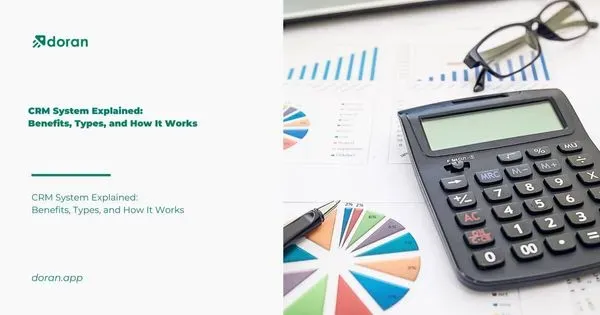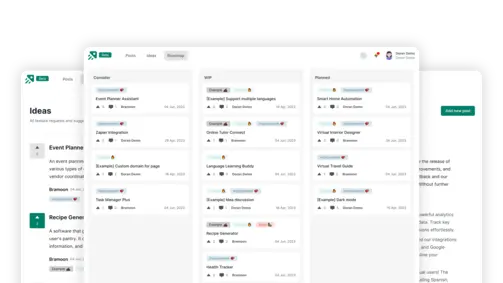Agile Excellence: Agile Product Roadmap Examples
Create changelog and product roadmap for your product
Explore nowTable of contents 9 min
In today’s fast-paced business landscape, the agile approach to product development has become a cornerstone of success. This article delves into agile product roadmap examples, shedding light on how organizations harness this approach to deliver products that meet the market expectations and stand out in the market. Whether you’re a product manager, an entrepreneur, or part of a development team, understanding these real-life examples illustrates the power of agility in responding to changing market dynamics. Join us as we explore how agile product roadmaps transform vision into tangible results.
What is an Agile Product Roadmap?

Before looking at some of our agile product roadmap examples, let’s find out together about the definition of an agile product roadmap.
Roadmaps help product owners and managers talk about where the product is going in the future. New features and functions are usually the focus, but there are other things discussed.
In a normal product roadmap, these improvements might have release dates listed. But in agile, it doesn’t make sense to stick to targets.
For agile development to work, you have to be able to adapt to new situations and meet changing needs at any time. Agile teams also spend less time guessing and predicting how long something will take. Instead, they use that time to try new things and build the product.
Fixed capacity is another important idea in agile. To do this, we build cross-functional teams that are stable and last a long time. When we do this, our capacity stays the same. The only things that change are the scale and/or the time. Because of this, you can’t tie features to times in agile.
In agile product roadmaps, the scope stays flexible when we need to set fixed dates. In agile, you can’t set a fixed time limit or goal.
Because of this, an agile roadmap gets rid of the idea of product deadlines. They still use the idea of time (for example, “feature A will come before feature B”), but nothing is tied to a certain date.
More to read: Charting Success with Zero Cost: Best Roadmap Tools Free
What are the Elements that Make a Product Roadmap Agile?
We must first emphasize a few fundamental ideas of agile teams to comprehend what constitutes an agile product roadmap.
Agile teams, as previously said, aim to adapt to changes. In agile, we fix capacity instead of scope and/or time.
From there, flexibility in scope and/or time is required. This is so because agile prioritizes adaptability above completing a predetermined scope of work in a set amount of time.
Agile’s second core idea is to prioritize value, or more precisely, results over output. Agile teams know that just because a new feature or product is released, it doesn’t guarantee that users will use it, pay for it, or find value. Moreover, these factors don’t always correlate with improved business results (i.e., revenue, customer advocacy, retention, etc).
Thus, meeting deadlines is not the primary indicator of success in agile product development. Excessive expenditure of time and money on non-impact items for customers or the business carries some risk.
Timelines are eliminated in agile roadmaps. Advanced agile product roadmaps also prioritize results over scheduling work or adding features to a list to meet release deadlines.
Find out more: The Importance of customer feedback to SaaS Founders
How to Design an Agile Product Roadmap

Designing an effective Agile product roadmap is a strategic endeavor that requires careful planning, collaboration, and adaptability. A well-crafted roadmap serves as a dynamic blueprint, guiding development teams through the intricacies of iterative development. Let’s explore the key steps to design an Agile product roadmap, incorporating elements like sprints, backlog, and SCRUM.
Define Clear Objectives and Goals
Begin by outlining the overarching objectives and goals for your product. What is the problem you aim to solve or the value you want to deliver to users? Establishing a clear vision provides a foundation for prioritization and decision-making throughout the Agile development process.
Break Down Goals into User Stories and Features
Translate your high-level goals into actionable items known as user stories. User stories represent specific functionalities or improvements from an end-user perspective. These stories are then organized into a product backlog, a dynamic list that evolves based on changing priorities and requirements.
Prioritize the Product Backlog
Prioritization is key in Agile product development. Collaborate with stakeholders, product owners, and development teams to determine the priority of each backlog item. Consider factors such as customer value, market demand, and dependencies between features. This prioritized backlog becomes the foundation for sprint planning.
Embrace the Sprint Model for Iterative Development
Divide your development timeline into sprints, typically lasting two to four weeks. Each sprint should have a specific goal or set of user stories to complete. This iterative approach allows for continuous feedback, adaptation, and the delivery of valuable increments at the end of each sprint.
Leverage SCRUM Ceremonies for Effective Collaboration
Implement the SCRUM framework to facilitate collaboration and coordination among team members. SCRUM ceremonies, such as sprint planning, daily stand-ups, and retrospectives, provide structured opportunities for communication, feedback, and adjustment. These ceremonies ensure that the team stays aligned with project goals and adapts to changing priorities.
Visualize the Roadmap for Transparency
Utilize visual tools like Gantt charts, Kanban boards, or specialized Agile project management software to represent your product roadmap. Visualization enhances transparency, allowing all stakeholders to understand the development progress, upcoming features, and potential roadblocks.
Continuously Review and Adapt
Agile product development is inherently flexible. Regularly review the roadmap, assess feedback, and be ready to adapt to changing circumstances. Embrace a culture of continuous improvement, using retrospectives to reflect on what worked well and areas for enhancement in each sprint.
Designing an Agile product roadmap is a collaborative and iterative process that combines strategic planning with adaptability. By following these steps, teams can create a roadmap that not only guides development efforts but also fosters agility, responsiveness, and successful product delivery.
Agile Product Roadmap Examples
Now-Next-Later
The Now-Next-Later roadmap is the most often used agile product roadmap framework.
To accommodate flexibility, things can be categorized into Now, Next, and Later groups. Things can often change in the Next and Later columns without affecting expectations for the exact delivery date. This makes it simple to modify and adjust your roadmap.
Additionally, the Now-Next-Later prevents the work from being dependent on time while maintaining a sense of time. We are aware that items in the “Now” bucket will arrive shortly, items in the “Next” bucket will arrive after items in the “Now” bucket, and those in the “Later” group will arrive at a later date. This preserves flexibility while enabling sufficient information to assist in setting expectations.
As previously indicated, more sophisticated agile product roadmaps will convey the goal that the team is presently pursuing. They might also hint at potential future developments.
Doran

Doran emerges as an exceptional tool for crafting Agile product roadmaps, offering a user-friendly interface and robust features that cater to the dynamic nature of iterative development. With Doran, teams can seamlessly define and prioritize objectives, breaking them down into user stories and features effortlessly. The platform’s intuitive backlog management enables collaborative prioritization, ensuring that development efforts align with strategic goals. Doran’s integration of the sprint model facilitates iterative cycles, allowing teams to focus on specific goals within well-defined timeframes. Leveraging SCRUM ceremonies becomes a streamlined process, fostering effective communication and coordination among team members. Moreover, Doran’s visualization capabilities, including Gantt charts and interactive boards, provide stakeholders with transparent insights into project progress and upcoming milestones.
ProdPad

(ProdPad) The second name in our list of agile product roadmap examples is called ProdPad. ProdPad was one of the first software to use an agile product roadmap. The Now-Next-Later format is used for its public product roadmap.
Slack

(Slack) The next example in our agile product roadmap examples list is Slack. The agile product roadmap for Slack is a variation of the style “Now-Next-Later.” It sorts things into categories called “Near Term,” “Mid-Term,” “Long Term,” and “Released.”
Quarters
Bucketing work into quarters is a comfortable middle ground that many agile teams use if going to zero timeframes is too much of a jump for you and your business.
Using quarters offers flexibility in precisely when something will be delivered within that quarter, much like Now-Next-Later. This strategy has the drawback that anything beyond the quarter could be seen as not meeting expectations.
Atlassian

Atlassian is a famous name in many of our agile product roadmap examples. Atlassian’s roadmap is not set up in a kanban style, but it does use concepts like “Now,” “Next,” and “Later,” as well as quarters.
Things are marked as “Future,” “Coming Soon,” and “Released.” They also have a date that goes with them, which gets more accurate as the release date gets nearer.
For instance, items marked “Future” have a draft year written next to them, while items marked “Coming Soon” have a draft quarter written next to them.
As we explore agile product roadmap examples, remember that adaptability and responsiveness are not just buzzwords; they’re the lifeblood of modern product development. By embracing the insights from this guide, you’re poised to understand agile product roadmaps and implement them as dynamic tools for innovation and sustainable product development. Your journey to agile excellence has just begun.
What to not miss out on our blog
Gain insightful knowledge and invaluable experiences from dedicated experts.

CRM System Explained: Benefits, Types, and How It Works
Discover everything about CRM system. Learn the benefits and how a CRM system works to improve customer relationships and streamline business operations.

Are you ready? Start your free trial today.
Enhance communication, keep track of the progress, understand customers' insight and more by taking your first trial on Doran.
Sign up for free

